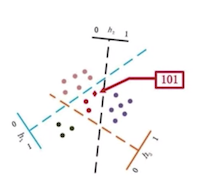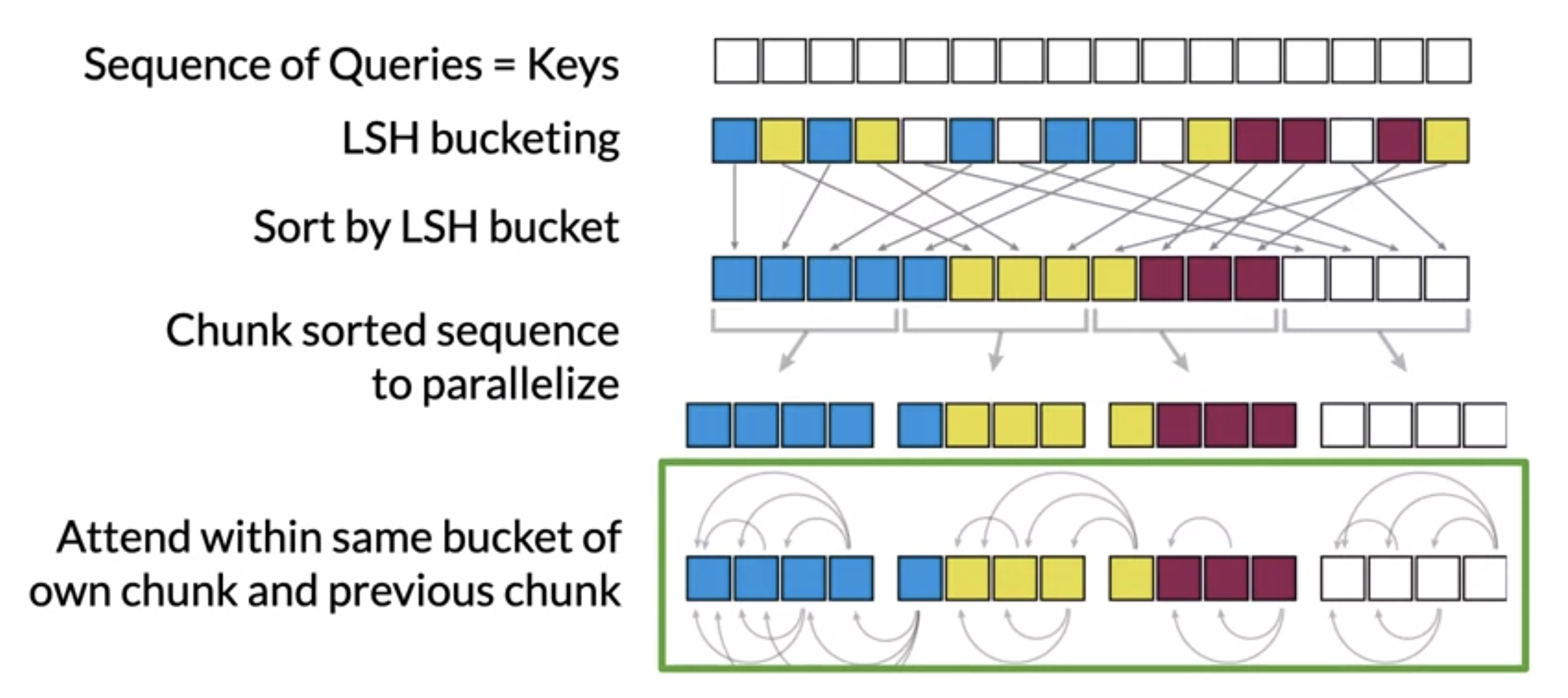Motivating Tasks with Long Sequences
- Transformers work well on fairly long sequences
- However, if sequences grow extremely long, the transformer must be tweaked to receive the necessary performance improvements
-
There are a growing number of NLP tasks requiring longer sequences:
- Writing books
- Storytelling
- Building chatbots
-
The transformer models behind these tasks become slow for training
- Due to the increased size of inputs
- Thus, slowing the training of these very long sequences
-
Many are based on the GPT-3 transformer model
- This is just a larger version of GPT-2
-
Unfortunately, training these models can require:
- Industrial compute resources
- Industrial cost
-
Processing long text sequences is at the core of building chatbots
- A chatbot must use every previous piece of the conversation as inputs for the next reply
- This leads to very large context windows
How Chatbots Differ from Question and Answering
- Recall, contextual question and answering models require both a question and a relevant answer during testing and evaluation
-
Whereas, closed-loop question and answering models don't require a relevant answer during testing and evaluation
- The relevant answers have already been learned during training
- All the knowledge is stored in the weights of the model itself during training
- This is how a chatbot functions
Describing the Complexity of a Transformer
-
Training transformers on larger sequences becomes slow
- The number of parameters required for an accurate enough model grows to be a very large number
- Consequently, modern GPUs will run out of memory when trying to load all of these parameters
-
The two primary causes of this memory inefficiency are:
-
Increasingly longer input sequences
- Mathematically, this correlates with more attention computations
-
Larger hidden layers
- Mathematically, this correlates with more saved
-
-
Calculating attention scores on an input and output sequence of length takes time and memory
-
Suppose
- Then operations is computed per second
-
Suppose
- Then operation is computed per seconds
- Modern GPUs perform around operations per second
-
-
Having layers of attention takes times as much memory
- GPT-3 already has layers
- Even modern GPUs can struggle with this kind of dimensionality
-
Recall, an attention score is the
- Where is a query
- Where is a key
- Where is a value
-
, and are all of dimension
- Where is the length of a sequence
- Where is the depth of attention
- Thus, will in length
Summarizing the Problems Causing Transformer Complexity
-
Again, the two primary causes of memory inefficiency are:
- Longer sequences leading to more attention computations
- Larger hidden layers leading to more saved forward-pass activations used in backward propagation
-
LHS attention layers solve our first problem
- Keep in mind, when handling long sequences, we usually don't need to consider all positions
- Instead, we can just focus on an area of interest instead
-
For example, suppose we're translating long English text to German
- We don't need to consider every English word at once
-
Instead, we can use attention and focus on the following:
- A single English word being translated
- Those words immediately around that English word
-
Reversible residual layers solve our second problem
- Generally, the more layers a model has, the more memory it needs
- Since, we must store the forward pass activations for backprop
- We can overcome this memory requirement by recomputing activations
- However, it needs to be done efficiently to minimize taking too much extra time
-
For example, GPT-3 would take a very long time to recompute activations
- Thus, we need a way to speed up this re-computation, such that it's efficient to use less memory
Motivating LHS Attention
- To motivate LHS attention, we'll map words to other potentially relative words based on its attention scores
-
Notice, the attention scores of it only focuses on certain words
- On the left panel, it refers to animal instead of street
- On the right panel, it refers to street instead of animal
-
For both sentences, there are only a few relevant attention scores
- Specifically, we're only really interested in the nouns
-
Thus, we only should be interested in keeping the relevant attention scores for each word
- To do this, we can use KNN with locality sensitive hashing
Illustrating LSH Attention
-
We can use locality sensitive hashing (LSH) to reduce the computational costs of finding nearest neighbors
- The same approach can be applied for computing attention
-
Using LSH, we can hash both the query and key
- This helps group similar query and key vectors together
- In other words, this helps us group nouns with pronouns
- Then, we'll only need to run attention on keys that are in the same hash buckets as the query
- When choosing the hash, the bucket roughly must be the same sizes
-
Here, the hash of x equals the following:
- is a random coefficient
- The size of is for dimension the number of hash bins
- The value determines the side of the plane the hash lands on
- This process is repeated for each hash value
-
LSH is a probabilistic, not a deterministic model
- This is because of the inherent randomness within the LSH algorithm
- Meaning, that the hash can change along with the buckets a vector finds itself mapped to

Defining the Steps of LSH Attention
-
These are the LSH steps applied to attention scores:
-
Modify the model so it outputs a single vector at each position
- Each vector is mapped to the relationship between a and
- This is referred to as attention
- Hash and to map each vector to a bucket with LSH
- Sort the vectors by LSH bucket
-
Perform standard attention within the same hash bins (LSH buckets)
- This reduces the search space for each to the same LSH bucket as
-
Take advantage of hardware parallelism by performing batch computation
-
Split the sorted sequence into fixed size chunks
- This allows for some parallel computation
-
Let each chunk attend within itself and the adjacent chunks
-
This covers the case of a hash bucket that is split over more than one chunk
- E.g. the blue, yellow, and magenta buckets
-
-
-

Introducing a Reversible Residual Layer
- Suppose we're interested in learning the text of an entire book
- We could input the tokenized words into a transformer
- Meaning, possibly million tokenized words would be processed
- Each token has an associated feature vector of some size
-
Meaning, just the input for the model could be in size
- On a GPU, this is of the total memory budget
- Notice, we haven't even touched the layers yet
- The size of the inputs and outputs for each layer will also be
-
To do backpropagation through this model, the forward path will need to store some intermediate quantities in memory
- These are the forward-pass activations for each layer
-
Saving these activations would use around of memory
- This won't fit on a single device
- Keep in mind, the latest transformers are much deeper than layers
- Fortunately, reversible residual layers can mitigate this problem
- To do this, they efficiently save activations for the backward path
Defining a Reversible Residual Layer
-
This transformer repeatedly adds residuals to the hidden states
-
There are only two hidden states used in transformers:
- Feed forward layers
- Attention layes
-
-
To run it in reverse, you can subtract the residuals in the opposite order
- Starting with the outputs of the model
-
In order to save memory used to store the residuals, we must recompute them quickly
- This is where reversible a residual layer (RRL) comes in
-
The general process of RRL is the following:
-
An RRC must start with two copies of the model inputs
- This enables reversible residual blocks
- Each layer only computes one of the copies
-
The activations unused in updates will be used to compute the residuals
- Now, we can run the network in reverse
-
-
The activations in the model are now twice as big
- However, we don't need to cache for the backwards pass now
- The standard transformer represents the normal residual connections
-
The standard transformer uses the following formulas:
Attention Layer:Feed-forward Layer:
-
The RRL uses the following formulas:
Attention Layer:Feed-forward Layer:
- To save memory, we reconstruct the inputs and :
- Essentially, we're computing using one side of the network plus feedforward of the other side to compute
- Similarly, one side of the network attention of the other side to compute
- By doing this, we can recompute and efficiently
Defining a Reformer Model
- Week 4: Video: Reformers
References
- Stanford Deep Learning Lectures
- Stanford Lecture about LSTMs
- Lecture about the Complexity of Transformers
- Lecture about LHS Attention
- Lecture about Reversible Residual Layers
- Lecture about the Reformer Model
- Paper about the Efficient Reformer Model
- Google AI Article about Attention Scores
- Paper about Alignment and Attention Models
- Post about Attention with Recurrent Neural Networks